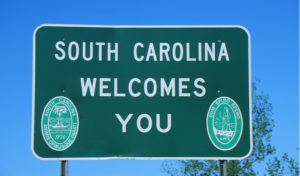
By Joseph Sohm @ Shutterstock.com
While high tax Northern states are desperately attempting to find ways around new rules in the tax reform legislation passed at the end of 2017, the South is cheering them on. The problems stem from high state and local income and property taxes in the North that will no longer be fully deductible for federal tax purposes.
Meanwhile, in the low tax South, those issues aren’t a concern, and a lower federal corporate rate looks great to the states that have made themselves attractive to big employers with Right to Work laws and low state taxation.
Cameron McWhirter and Arian Campo-Flores write in The Wall Street Journal:
Southern states, where economic growth is outpacing Northern counterparts, are predicting that a new $10,000 cap on the federal deductions taxpayers can take for state and local taxes will make low-tax states more attractive for workers and businesses.
The South’s optimism contrasts with worries in many Northern states that the changes will hurt their economies, where higher state and local taxes were offset, in part, by federal deductions for decades. New York Gov. Andrew Cuomo, a Democrat, said earlier this month he would sue the federal government for the tax changes, which he described as “an arrow aimed at New York’s economic heart.”
Southern states have been drawing migrants from Northern states for years, making it now the most populous region in the country—a demographic shift that Mark Vitner, a Charlotte, N.C.-based senior economist for Wells Fargo & Co., calls “the affordability migration.”
Property tax rates in the North are generally higher than down South, according to a 2015 report by the Tax Foundation, a conservative Washington-based group that tracks taxation across the U.S. The foundation found that the mean effective property tax rate in New York was 1.64% and 2.32% in Illinois, compared with 0.75% in Tennessee and 1.06% in Florida. Florida has no state income tax, while Tennessee has no state taxes on wages.
Job growth in the South has outpaced that in the Northeast in recent decades. Nonfarm employees in the region—as defined by the U.S. Census Bureau—of 16 states and the District of Columbia rose 23% between 1997 and 2016, outpacing the 17% growth of the national workforce, according to the U.S. Bureau of Labor Statistics. In the Northeast, growth was 12%.
Read more here.
President Donald Trump signs Tax Cuts and Jobs Act in Oval Office | ABC News Special Report
E.J. Smith - Your Survival Guy
Latest posts by E.J. Smith - Your Survival Guy (see all)
- A Word on Stocks - July 26, 2024
- Is Vanguard Too Big? What’s Next? - July 26, 2024
- Boomer Candy? - July 26, 2024
- My BEST Insider’s Guide to Key West - July 26, 2024
- Having Fun Yet? Nasdaq Worst Day in Years - July 25, 2024














